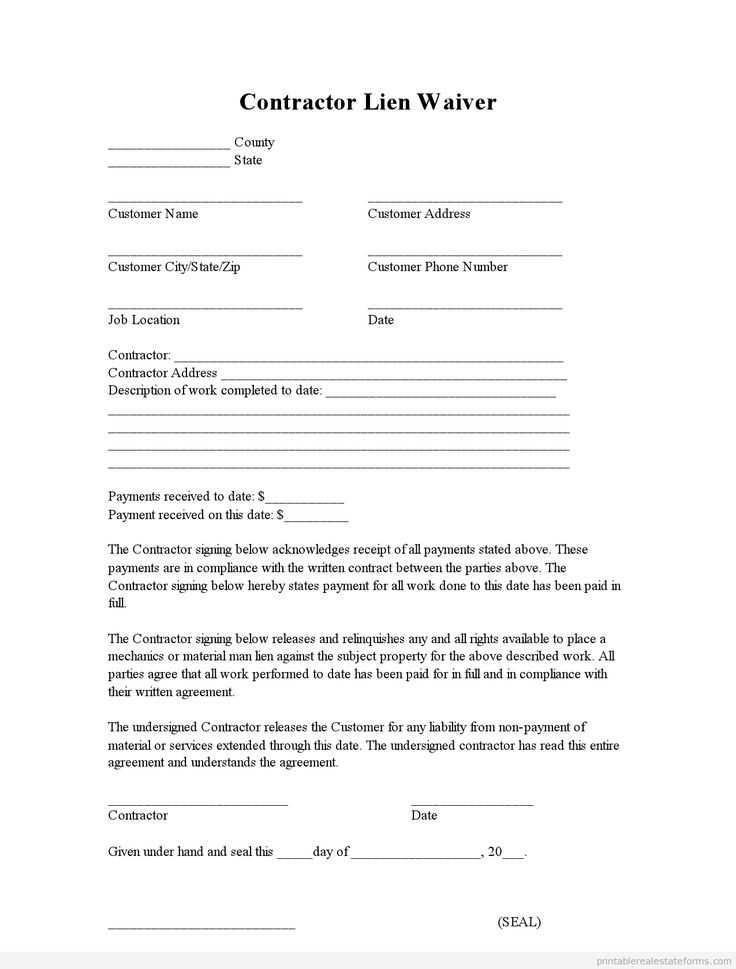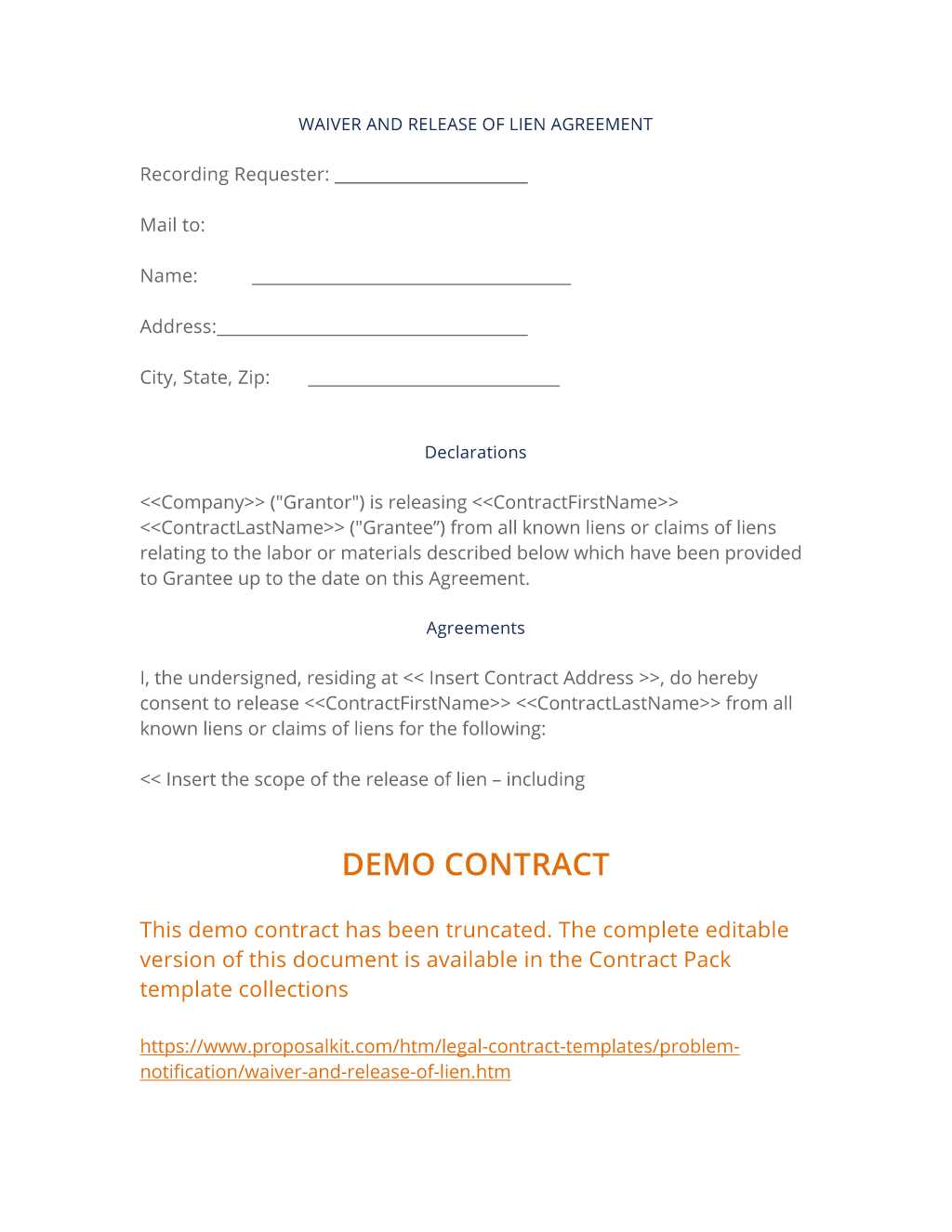Auto Lien Release Letter Template Guide

When it comes to transferring vehicle ownership, there are certain legal steps that must be taken to ensure everything is properly documented. One of the most important actions in this process is confirming that any previous financial obligations tied to the vehicle have been cleared. This is essential for a smooth transition to the new owner and to avoid future complications.
In this article, we will walk you through how to create a document that verifies the removal of any claims on the vehicle. It is crucial to understand the specific information that needs to be included, as well as how to format it correctly to ensure its validity. This document not only serves as a proof of ownership but also protects both the buyer and seller from potential legal disputes.
Getting it right is key, and we will cover the necessary steps to help you avoid common pitfalls. By following the guidelines provided, you can easily draft an effective document that meets legal requirements and simplifies the transfer process.
Understanding the Vehicle Ownership Clearance Process
When purchasing or selling a vehicle, it’s essential to confirm that there are no outstanding financial claims on the asset. This process ensures that the new owner can enjoy full rights to the vehicle without any future complications. It involves verifying that all previous debts or obligations tied to the vehicle have been resolved, allowing for a smooth transfer of ownership.
Typically, this process begins when the individual or institution holding the financial claim on the vehicle confirms that the debt has been satisfied. Once cleared, the next step is to formally document the release of this claim, signaling that the vehicle is free from any legal encumbrances. The proper documentation serves as an assurance for both the buyer and the seller that the transfer is legitimate and legally binding.
Key steps in this process include:
- Confirming that all outstanding debts have been paid off.
- Obtaining official clearance from the entity holding the claim.
- Completing necessary paperwork to verify the clearance.
- Submitting documents to relevant authorities, if required.
It is important for both parties involved to ensure that all steps are followed correctly. Incomplete or improperly documented transactions can result in legal disputes or complications in transferring the vehicle’s title. This process provides clarity and protection, ensuring a smooth transition from one owner to the next.
Why You Need a Claim Removal Document
When transferring ownership of a vehicle, it’s essential to confirm that any previous financial obligations tied to the asset have been settled. Without proper documentation stating that these obligations have been cleared, both the buyer and seller may face legal and financial risks. A properly issued document ensures that the buyer gains full rights to the vehicle, free from any future disputes.
Such a document provides crucial proof that the previous financial encumbrances have been resolved. This not only protects the buyer from inheriting unexpected debts but also assures the seller that they are no longer responsible for the vehicle. Without this confirmation, ownership transfer could be delayed, or worse, disputed in court.
Key reasons why this document is necessary:
- Clear Ownership Transfer: It ensures that the buyer receives clear title to the vehicle.
- Prevents Future Legal Issues: It helps avoid complications or disputes over ownership.
- Financial Protection: It safeguards the buyer from taking on past debts.
- Legal Requirement: In some jurisdictions, this document is a necessary step for a valid transfer.
Without this document, the transfer process could be hindered, potentially leading to confusion and legal troubles. It is an essential part of ensuring a smooth and legally binding exchange of ownership.
Steps to Draft a Claim Removal Document

When preparing a document to confirm that all financial obligations tied to a vehicle have been satisfied, it is important to ensure the content is clear, accurate, and legally sound. This document serves as the official proof that the vehicle is free from any remaining financial encumbrances, which is vital for the buyer and seller. Below are the necessary steps to draft such a document effectively.
The first step is to gather all relevant information. This includes details about the vehicle, such as the make, model, and VIN (Vehicle Identification Number), as well as the full name and contact information of both the individual releasing the claim and the person receiving it. The exact nature of the financial settlement should also be referenced.
Next, the document should include a clear statement confirming that all financial obligations on the vehicle have been fully satisfied. It is crucial to specify that no further claims exist and that the vehicle is now free from any financial encumbrances.
Finally, make sure to include spaces for both parties to sign and date the document. The signatures provide official validation that both the release and the transfer of ownership have been agreed upon. In some cases, it may be necessary to have the document notarized to add an additional layer of legal authenticity.
Essential Elements of the Document
When drafting a document to confirm that all financial obligations associated with a vehicle have been cleared, it is essential to include specific details to ensure its validity. The document must clearly demonstrate that the previous claims have been settled and that ownership can be transferred without any future legal complications. Below are the key components that should be included in the document to make it effective and legally binding.
Key Information to Include

Start by providing all relevant details regarding the vehicle. This includes the vehicle’s make, model, year, and Vehicle Identification Number (VIN). Additionally, the names and contact information of both the individual releasing the claim and the individual receiving the vehicle must be clearly stated. These details ensure that the document pertains to the specific transaction and provides a point of contact for any future queries.
Statement of Claim Satisfaction
The most crucial part of the document is the statement confirming that the financial obligations associated with the vehicle have been fully satisfied. This section should clearly indicate that there are no remaining debts or claims tied to the vehicle. It must be unequivocal in stating that the asset is free from any financial encumbrances, ensuring the buyer can take full ownership without any further responsibilities.
Common Mistakes to Avoid in the Document

While drafting a document to confirm that all financial obligations tied to a vehicle have been cleared, it’s easy to make mistakes that could affect its legal validity. These errors can lead to confusion, delays, or even disputes over ownership. Understanding and avoiding these common pitfalls will help ensure that the document is clear, accurate, and properly executed.
One of the most frequent mistakes is failing to include all the necessary vehicle details, such as the make, model, and VIN. Incomplete or incorrect vehicle information can make the document invalid, as it won’t clearly link the document to the specific asset being transferred. Additionally, leaving out the full names and contact details of both parties involved can lead to confusion in case of future disputes.
Another mistake is not clearly stating that the financial obligations have been fully satisfied. Vague language or failure to explicitly confirm that there are no outstanding claims could leave room for doubt, potentially causing problems for the buyer. Ensure the statement is definitive and precise.